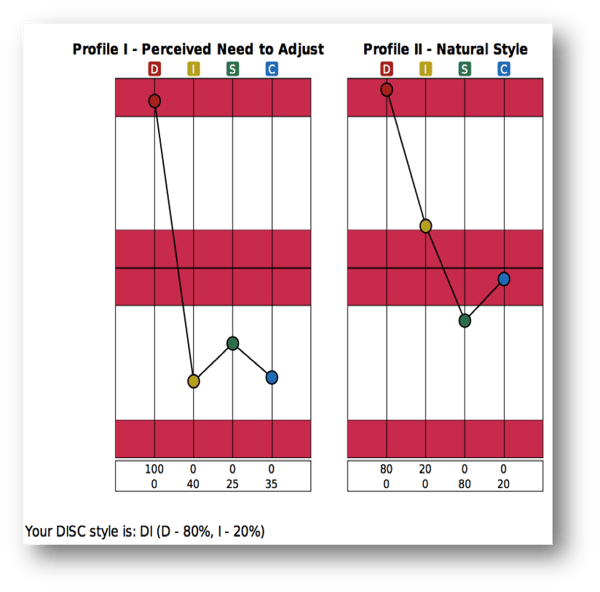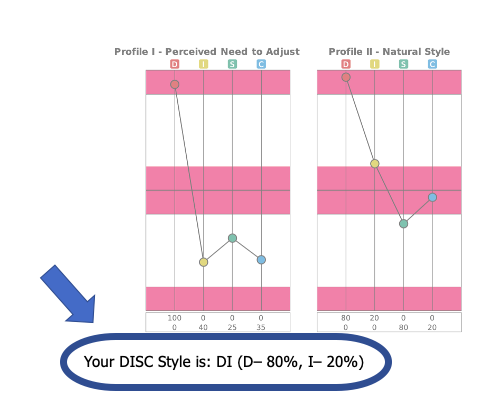Read this if you could use tips on debriefing DISC Profiles.
Many of you debrief DISC Assessment results regularly with your clients and employees. You may be doing it in a workshop or one-on-one. Regardless of how you debrief, we have some tips and brief refreshers to help you and your clients better understand their Profiles results.
Why DISC results are not all the same
 It's not uncommon for your participants to tell you they've already taken a DISC Assessment. Your best response should be, "That's great! Was it the Extended DISC Assessment?" People don't often realize the DISC model is universal, but not the tools.
It's not uncommon for your participants to tell you they've already taken a DISC Assessment. Your best response should be, "That's great! Was it the Extended DISC Assessment?" People don't often realize the DISC model is universal, but not the tools.
In fact, there are different DISC tools available; sometimes measuring different things. DISC tools are based on the DISC Model and describe main DISC styles similarly, but they may vary on what is measured and how they present the results.
Extended DISC identifies your present perceived need to adjust style and your natural style, but focuses on your natural style. You can make better decisions because the results show who you really are. Your natural style predicts the behaviors which are most comfortable to you; how you prefer to do things and how you show up when you're not adjusting.
Do you trust the results? One thing we should always ask when using assessments is, "can we trust the results?" We make important decisions off of the results so accuracy is critical. Revalidation and international validation (not just one country or one language) strengthens the confidence in your results.
Now, let's look at debriefing Profile results.
Profile results

The Profiles graphs are a visual representation of your DISC style. They are based on your responses to the Extended DISC® Questionnaire. The Questionnaire generates two Profile graphs, Profile I and Profile II. Profile I represents your perceived need to adjust in your present environment and Profile II represents your natural style.
A great tip, as a coach, is to also view the Profiles first. One reason, is you want to determine if you can trust the results. Long, stretched Profiles provide confidence in results interpretation. The larger the gap between the dominant style (highest plot point) and the least comfortable style (lowest plot point), the more clearly and consistently you are identifying your natural style over your style that is not natural to you. In the Profile II - Natural example above, the person is a dominant D-style and their least comfortable style is S-style. You can see a clear gap between the D plot point and the S plot point.
Tips to debrief Profile I
Profile I describes how you feel you need to make adjustments in your present environment. A great analogy is to describe it as a snapshot of how you felt you needed to be at the time of the assessment. It is your transient profile; meaning that it constantly changes as your perceived reaction to your environment changes.
Another tip is to not put a lot of emphasis on Profile I. Remember, the title is "perceived" need to adjust. It is simply your belief of how you feel you need to adjust your natural style at the present time. However, the perceived adjustments are not automatically the best ones. For example, you may perceive you need to speed things up and take more risks, but that may not be what your manager believes.
The last tip to always interpret Profile I by comparing it to Profile II. Profile I is all about your adjustments. In order to understand the adjustments, you need have a starting point. Profile II - Natural Style describes your most comfortable way of doing things; hence, it's your base point.
Tips to debrief Profile II
Unlike transient Profile I, Profile II tends to remain stable, but not rigid, throughout the course of your adult lifetime. Profile II is your natural style. The easiest way to describe it is it's your most comfortable way to do things; how you prefer to communicate, how you prefer to make decisions, how you prefer to lead, etc. It focuses on who the person really is.
The graph describes the relationship of all four DISC styles, but it is not an absolute scale. If your D-style is plotted higher than your colleague's it does not automatically mean you are "more" D than they are. Also, if your D-style is plotted at the very top it does not necessarily mean you are the ultimate D; it simply means that you very consistently and strongly self-identified with D-style when answering the Questionnaire.
As DISC facilitators, we should always reinforce the concept that we have all four DISC styles; it's just some styles are comfortable and some are not. It's not about your abilities and it does not predict your success. You can help your participants understand their results by describing DISC styles in terms of energy; some styles don't take energy from you and some do.
A few final and important tips
 You know your audience best; there is no one way to debrief the results. However, you should always put the emphasis on Profile II - Natural Style. It helps people better understand their results because the report is primarily based off of Profile II. Understanding your natural style provides a clear starting point to make more effective adjustments and further development.
You know your audience best; there is no one way to debrief the results. However, you should always put the emphasis on Profile II - Natural Style. It helps people better understand their results because the report is primarily based off of Profile II. Understanding your natural style provides a clear starting point to make more effective adjustments and further development.
Your participants do not need to interpret their Profiles to understand the report results. Have them zero in on the statement directly under the Profiles. You can see in the example the statement reads, "Your DISC Style is: DI (D-80%, I - 20%." Often times, we conduct workshops where we don't need to or have have time to do a deep dive into interpreting the Profiles. Once they are able to identify their DISC style from the statement, they are ready for the rest of their report.
A final tip is to help them interpret their Profile results. We, as facilitators, can tell them their DISC Profile and what their Perceived Need to Adjust Profile is, but we cannot explain why they are a certain style and why they want to adjust in the way they do. What we can do is to ask more open ended questions such as, "what do you think of your results" or "how does that reflect where you are right now"? It gives them the chance to process the results and reflect on how they are needing to adjust.
Now, they are able to use the results of their report to create a behavioral action plan for improving their interactions. Ultimately, the goal of using the assessment is to help people be more successful.
Hope that helps and don't forget to practice interpreting Profiles!

